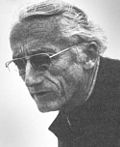Portal:Geography
Sociology portals: Arts · Anthropology · Community · Culture · Economics · Education · Geography · Gender studies · Globalization · History · Human rights · Internet · Law · Philosophy · Social movements · Social sciences · Social welfare and social work · Society
The Geography PortalGeography is the science that studies the lands, the features, the inhabitants, and the phenomena of the Earth. A literal translation would be "to describe or write about the Earth". The first person to use the word "geography" was Eratosthenes (276–194 BC). Four historical traditions in geographical research are the spatial analysis of the natural and the human phenomena (geography as the study of distribution), the area studies (places and regions), the study of the human-land relationship, and research in the Earth sciences. Modern geography is an all-encompassing discipline that foremost seeks to understand the Earth and all of its human and natural complexities—not merely where objects are, but how they have changed and come to be. Geography has been called "the world discipline" and "the bridge between the human and the physical science". Geography is divided into two main branches: human geography and physical geography.
Featured article
Bryce Canyon National Park is a national park located in southwestern Utah in the United States. Despite its name, this is not actually a canyon, but rather a giant natural amphitheater created by erosion along the eastern side of the Paunsaugunt Plateau. Bryce is distinctive due to its unique geological structures, called hoodoos, formed from wind, water, and ice erosion of the river and lakebed sedimentary rocks. The red, orange and white colors of the rocks provide spectacular views. The canyon area was settled by Mormon pioneers in the 1850s and was named after Ebenezer Bryce, who homesteaded in the area in 1875. The area around Bryce Canyon became a United States national monument in 1924 and was designated as a national park in 1928.
In this month
Did you know...
Things you can doFeatured biography
Daniel Boone was an American pioneer and hunter whose frontier exploits made him one of the first folk heroes of the United States. Boone is most famous for his exploration and settlement of what is now the U.S. Commonwealth of Kentucky, which was then beyond the western borders of the Thirteen Colonies. Despite resistance from American Indians, for whom Kentucky was a traditional hunting ground, in 1775 Boone blazed the Wilderness Road through the Cumberland Gap and into Kentucky. There he founded Boonesborough, one of the first English-speaking settlements beyond the Appalachian Mountains. Before the end of the 18th century, more than 200,000 European people migrated to Kentucky and Virginia by following the route marked by Boone. He was a legend in his own lifetime, especially after an account of his adventures was published in 1784, making him famous in America and Europe. After his death, he was frequently the subject of tall tales and works of fiction. His adventures—real and legendary—were influential in creating the archetypal Western hero of American folklore. In American popular culture, he is remembered as one of the foremost early frontiersmen, even though the mythology often overshadows the historical details of his life.
CategoriesWikiProjectsFeatured pictureAn aerial view of Laguna Beach, a seaside resort city and artist community located in southern Orange County, California, US. The region was originally known to the Spanish as "La Cañada de Las Lagunas" which means "The Canyon of the Small Lakes", in reference to two lakes found near the head of Laguna Canyon. Selected quoteArticles
SubportalsRelated portalsAssociated Wikimedia |
- What are portals?
- List of portals
- Featured portals







